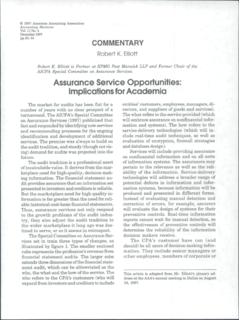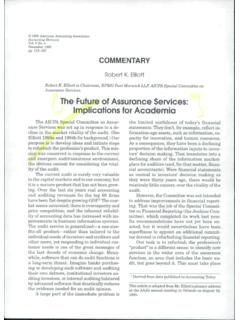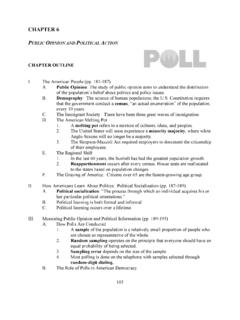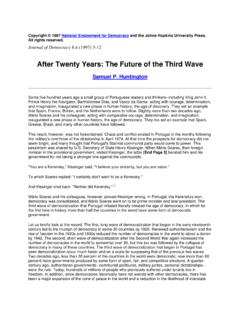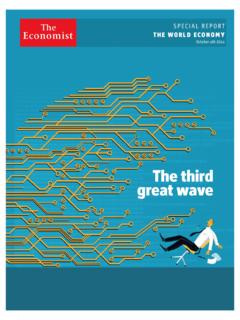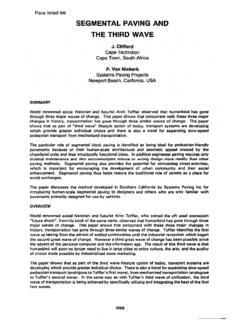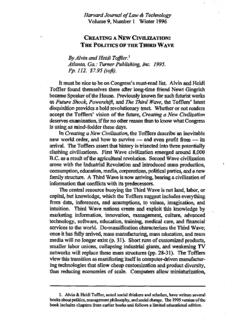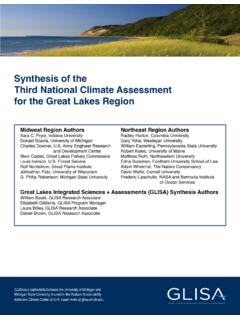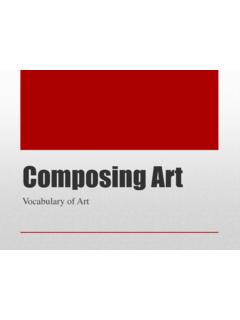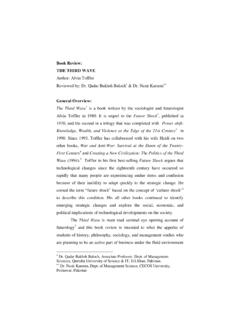Transcription of COMMENTARY - Rutgers University
1 COMMENTARYR obert K. ElliottonThe Thwd Wave Breaks on theShofe$ of AooountnigInformation technology (IT) is changingeverjrthing. It represents a new, post-indus-trial paradigm of wealth creation that is re-placing the indxistrial paradigm and is pro-fbiindly changing the way business is of these changes in business, the de-cisions that management must make are verydifferent fix>m former decisions. If the purposeof accounting information is to support busi-ness dedsion-making, and management's deci-sion types are changing, thenit is natural to expect ac-counting to change bothinternal and external ac-counting. Obviously, if busi-ness, management, and ac-counting change, accountingeducation and research mustchange: the types of studentsrecruited, the curriculum,the set of required capa-bilities of graduates, and theissues article begins bysummarizing the changesbeing driven by IT and theireffect on the needs for ac-coiinting information (sectionI).
2 Then the article summa-rizes the effect of both on needs for changesin internal accounting (section II), external ac-counting, including accounting standard set-ting (section III), pubUc accounting firms (sec-tion IV), accounting education (section V), andaccounting research (section VI). As thebreadth of these issues must signal, the ob-jective is to stimulate further thought and todemonstrate that it is IT IS THE DRIVERA lvin ibfQer's image of the " third wave"is a good model for considering economicFigure 18000BC 1650 1955 Thr fundamentally differentmethods of wealth each, a different form of ac-counting informatton is He notes, in his book The ThirdWave, that until about 8000 , the domi-nant mode of life was foraging, fishing, hunt-ing, and herding. You caught what you ate andyou ate what you caught. But, about 10,000years ago, agriculture was developed, and be-came the first m ijor new weali^-creating tech-nology.
3 Agriculture had momentous implica-tions for civilization, as formerly nomadicpeople became bound to the land they werecultivating. This led to re-quirements for defense, gov-ernment, and laws. It is ourfirst example of enormoussocial and economicchanges flowing from theintroduction of a agricultural para-digm of wealth creation wasdominant for about 10 mil-lennia, until the secondgreat wave of new technol-ogy occurred industry exploiting the discoverythat energy could be har-nessed to amplify humanlabor in the factory. Farmore raw material could beconverted to finished goods than with manuallabor alone. Industrialization also had hugeimplications for civilization, as the cities,where the factories were located, became moredensely populated, and marketplaces devel-oped for the exchange of increasingly special-ized products. This is otu* second example ofprofound social and economic changes flow-ing from the introduction of a new industrial paradigm was dominant fora much shorter time, until it began to be re-placed by the third great wave of change 62 Accounting Horizons I June 1992the information revolution.
4 This can be datedto the 1950s, with the invention of the tran-sistor and the installation of the first commer-cial computer (although the first computersused vacuum tubes, the happy marriage ofcomputing and semi-conductors was prompt).In the third wave , the engine that drives thesystem is not physical labor, as it is in agri-culture; not machines, as it is in industry; butinformation. As with prior waves of techno-logical change, we can expect important so-cial and economic changes, and we can alreadysee the dim outlines. These include the in-crease in economic power of those countriesthat can make the most effective use of knowl-edge-workers. They also include acceleratingthe demise of the socialist economies, whichcould only hang on during the relativelyslower rates of change in the industrial information age demands the rapid ad-aptation that a free market thrives on, andthe socialist systems were too phlegmatic govemmentally and managerially to three great waves of change havecharacteristic technologies in several dimen-sions (Figure 2).
5 There are character-istic information tech-nologies for each IT for the first wavewas writing, which wasdeveloped to keep ac-counting records. (If yousent a camel-load of spices to Damascus, youhad to have some way of knowing that thecamel driver was not misappropriating thecargo, so you needed a bill of lading, etc.)The IT underljdng the second wave wasmovable-type printing, which was developedby Gutenberg around 1450, although the on-set of the industrial age did not occur for sev-eral centuries thereafter. The development ofmovable type was a necessary (although notsufficient) condition for the industrial revolu-tion. For the first time, knowledge could comeout of the monastic libraries, where it hadbeen locked up in unique, handwritten the invention of movable type, bookscould be mass produced. Thus, informationTechnologyphysicalinformation accounting1at Wavelaborwritingsingle-entry2nd Wavemachineryprintingdouble-entryFigure 23rd Wavesemi-conductorscomputertriple-entry( ?)
6 Could be widely diffused, permitting the de-velopment of modem science and IT for the third wave is the digitalcomputer, making possible fast, inexpensiveinformation storage and processing. Whenharnessed to its full potential (that is, inconjunction with the associated software, databases, and telecommunications), the digitalcomputer permits vast leveraging of technologies also changewith the technological waves . In the firstwave, when events unfolded at the stately,annual pace of agriculture, simple account-ability concepts were sufficient. If you livedin ancient Egypt, the one thing you knew wasthat things were always the same. The suncame up every day in the east and went downevery day in the west. The Nile flooded everyyear, in the same season. For millennia, ev-ery year was identical. The idea of progresswas, to the ancient Egyptians, you were the Pharaoh, all you needed toknow was whether there was enough grain inthe storehouses to feed the people during theannual flood and buildanother your world isthis stable and pre-dictable, you need onlya very simple account-ing technology single-entry account-ing; you just count your assets and the second wave arrived, however,single-entry accounting was not began to move faster.
7 However, double-entry bookkeeping had already been codifiedby Pacioli in 1494. This development precededthe second wave, but double-entry bookkeep-ing was a necessary (although not sufficient)condition for the industrial revolution. Indouble-entry accounting, the debits equal thecredits. The debits represent the benefits tothe company and the credits represent thesacrifices. These debits and credits provide avery convenient way of l^eping track of a largenumber of contracts in various stages of ex-ecution committed, partially executed, andCommentary on the third wave Breaks on the Shores of Accounting63ww'w"fully-executed. A simple accounting entrycould record each stage of the contract. Thus,double-entry bookkeeping enabled an entityto keep track of a large number of contractsin various stages of execution. Abundle of con-tracts is nothing more or less than a corpora-tion, and a corporation is the vehicle requiredto aggregate the capital to build the factoriesand buy the machinery to have an industrialrevolution.
8 Althoughdouble-entry accountingdid not cause the indus-trial revolution, it couldscarcely have occurredwithout the is reasonahle toassume that the thirdwave will demand a newaccountahility technology. However, it has notyet emerged. Yuji Ijiri has proposed a systemof triple-entry accounting that is original anda major step in the right direction. In thismodel, the fiirst derivative of wealth with re-spect to time is income {w'), and the secondderivative of wealth with respect to time is"thrust" or the rate of change of income {w")Figure 3 summsuizes the these accounting levels in termsof the three waves of wealth creation: in thefirst wave, there was single-entry accounting accounting at the w(or wealth) level andthe prototypical finan-dal statement was a hal-ance sheet. In the secondwave, double-entry ac-counting permitted ar-ticulated statements ofposition and is at the w' prototypical finan-cial statement for thatwave was the incomestatement, and later thefunds flow (as a function of time)To the extent it measures at the w" level,it is a step in the right direction, hut it maynot go far enough to satisfy third -wave ac-countability needs.}}
9 The reason is that Ijiri'striple-entry accovmting operates on the sameindustrial-era resources and obligations as areincluded in today's financial statements,whereas the crudal assets for the post-indus-trial firm are very different assets, as dis-cussed below. In otherwords, a model based onsecond-wave concepts ofassets, liabilities, rev-enue, and expense is notlikely to be suf&dent forthe third three waves aresummarized in FigureFigure 3first derivative of wealth with respect totime (that is, income)second derivative of wealth with respect totime (that is, the rate of change in income)Wealth' Agricultural era8000 BCbut they are both at the same level of flow. Soif single entry was good for the first wave anddouble entry for the second wave, is triple en-try good for the third wave ?4. The "s" curves repre-sent the introduction, exploitation, and ma-turity of each wealth-creation paradigm. Aseach wave exhausts its potential, a new wavebegins.
10 Each new cxirve starts a little lowerthan where the last curve left off becausethere's a cost involved in switching firom onetechnology to another, and that cost is thetechnological discontinuity as people try to getoff the old curve and onto the new. Old jobsbecome obsolete, and people scramble to re-train and seek new types of jobs. Educationalrequirements shift, economic forms change,and, as noted above,there are large socialcosts.\The second period of/^ technological discon-/Ln . on .ra tinuity, between the sec-/ ond and third waves , in-cludes our entire profes-sional lifetimes. We areliving that technologicaldiscontiniiity, as peopledisplaced fix)m the sec-ond curve desperatelyseek a foothold on thethird curve. A dramaticFigure 4 Technological DiscontinuitiesTimeexample of this can be seen in Eastern Eu-rope, as the industrial to post-industrial shiftthat the West has had 35 years to assimilateis being crammed into a few months or Horizons I June 1992 Just because we are in a post-industrialeconomy doesn't mean that we can forget thefirst two waves .
